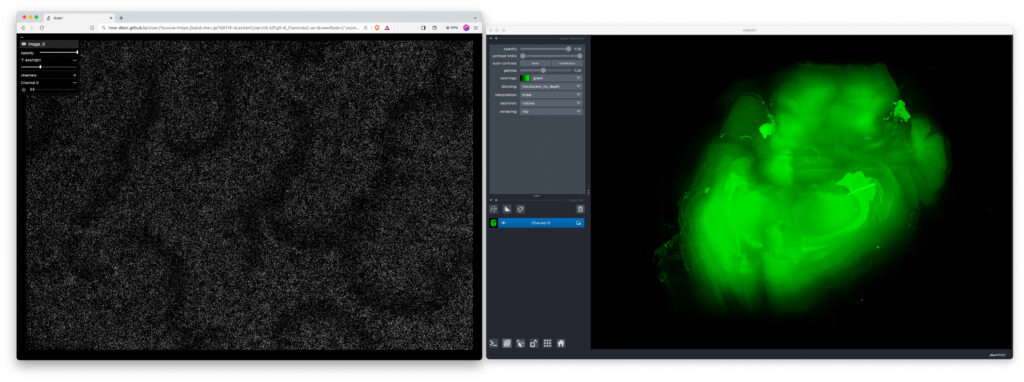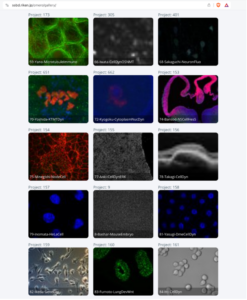Laboratory for Developmental Dynamics, RIKEN Center for Biosystems Dynamics Research (BDR)
Accelerating global sharing of bioimage data: Data publication generates a virtuous circle in life science
The field of life science is making progress in building a global image data sharing system. Shuichi Onami led the way by launching a bioimaging database (SSBD) in 2013, which is now one of the prominent image databases worldwide. As SSBD enables free use of cutting-edge microscopy image data, and invitations for collaborative research arrive from people viewing the image data we publish, it has generated a new virtuous circle.

Shuichi Onami
Team Leader
Laboratory for Developmental Dynamics, RIKEN BDR
A growing movement to share image data through cooperation across Japan, Europe, and North America
Imaging technology for visualizing in vivo information is very important for life science research; to say it is decisive for research competitiveness is no exaggeration. At the moment, because cutting-edge imaging equipment is crafted by individuals with high-level expertise or is commercially available only at very high prices, few people can use it. However, the open science movement has become active throughout the world in recent years. Publishing and sharing research data has become the norm.
This is the context in which projects to promote sharing of bioimage data are starting up. As chair of an international collaborative organization, I have pushed the creation of a global image data sharing system. Now, in addition to the SSBD database that I run, Europe has databases called BioImage Archive and IDR, and database preparation has recently started in the USA. In the future, we plan to link these databases together and create an image data sharing platform covering Japan, Europe, and North America.
A recent sharp rise in the number of registered datasets
SSBD was established in September 2013 with funds from the Japan Science and Technology Agency (JST). At first, SSBD collected and published image data and resulting quantitative data on biodynamics to be used in systems biology (examining biosystems as systems), which is my original research field. Since then, with advances in imaging technology, image data have become increasingly important. Nowadays SSBD collects mainly image data, but also biodynamics quantitative data and video images, as well as simulation data.
Particularly in the last few years, the number of datasets registered in the database has grown rapidly (Fig. 1). In 2020, the journal Nature included a special report on image data sharing in the life sciences that mentioned SSBD. This attracted great interest around the world.

Fig. 1: Trends in data registered with SSBD
More and more scientific journals are requiring that research data be published when articles are submitted. SSBD can be used as a platform for publishing these data. In SSBD, data are managed in a two-layer architecture. First, image data and such used in articles are associated with minimal metadata and archived in a common repository (SSBD:repository), enabling quick publication (Fig. 2). Of these data, data expected to have particularly high reusability, such as image data from leading-edge imaging technologies, are associated with rich metadata and published in a high-added-value database (SSBD:database). With this two-layer architecture, both rapid publication of data and easy reuse can be achieved.

Figure 2: Examples of bioimaging data shared in the SSBD
Chemotaxis data of hundreds of thousands of cells (left) and whole-brain imaging data of the cleared brain (right) are visualized by Vizarr and napari, respectively.
The benefits of sharing data: Promoting collaborative research and development of analysis techniques
Even with the growth of open science, many people feel reluctant to publish research data. As a researcher myself, I understand this feeling. However, from my own experience and from what other people have said, I am convinced that publishing data is tremendously beneficial both in advertising your own research and in bringing invitations for collaborative research. Of course, seeing published data can also make me think “if they can get this data, then that must be possible” and give me ideas to propose collaborative research myself.
Sharing image data also leads to an acceleration in the development of image data analysis techniques, like the great advances in bioinformatics that resulted from the sharing of genome information and 3D protein structures. There may be people who think their own data could be useful; for example, an AI researcher could use your data to develop an image analysis algorithm. This analysis technique would be well adapted to your data, which you could expect to result in future benefits for yourself. In fact, SSBD is used by many information science researchers. I hope that use of this data with unfettered ideas that would not otherwise occur to life science researchers will be useful for the development of analysis techniques.
I will be delighted to see lots of people sharing image data and keeping this virtuous circle turning.
(Article by: Chisato Hata/Photo by: Takuya Oshima/Production assistance: Sci-Tech Communications)








